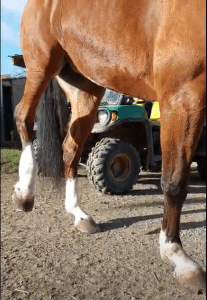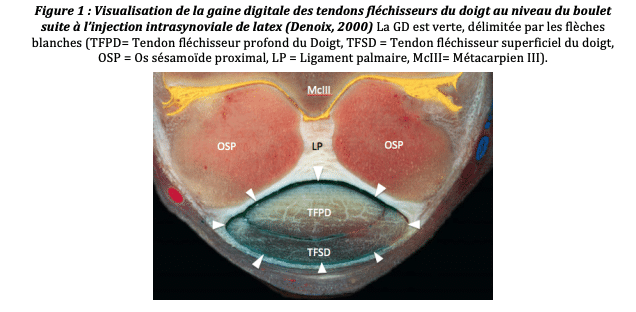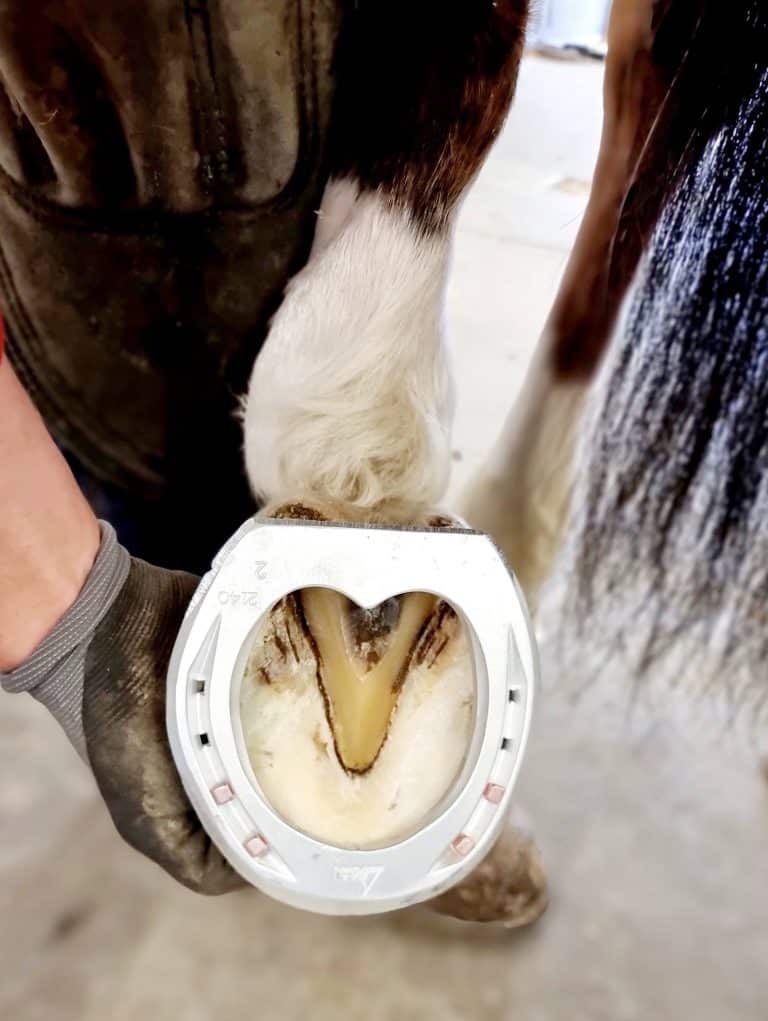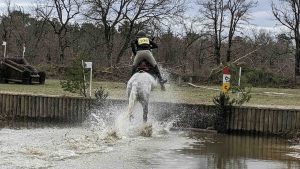
Focus on the management of a mare combining: severe chronic tenosynovitis, chronic tendinopathies of the superficial and deep flexor tendons of the same limb.
A challenge requiring collaboration between equine veterinary medicine and farriery, provided by the equine clinic from Grosbois (Val-de-Marne, France) and the farrier Alexandre Legrand (Nord, France).
Tenosynovitis, explanations
Tenosynovitis is an inflammation of the tendon sheath, the tissue surrounding a tendon. Tendonitis, on the other hand, is an inflammation of the tendon itself.
For horses, the sheath surrounding the superficial digital flexor tendon of the toe (SDFT) and the deep digital flexor tendon (DDFT) is called digital flexor tendon sheath (DFTS). The digital flexor tendon sheath allows especially the contention of the tendons and the sliding of the latter during movements.


The tendon sheaths are inspected via tenoscopy.
This surgical technique is minimally invasive and makes it possible to detect lesions and their importance, to clean infections, or to make corrections in the event of tendon or ligament tears.
The importance of the clinical symptoms varies depending on whether it is acute or chronic inflammation and whether other structures are affected (associated tendon or ligament lesions, presence of adhesions, etc.).
Common clinical manifestations of the tenosynovitis of the digital flexor tendon sheath for the horse are:
- The appearance of soft deformities (windpuffs) more or less solid whether or not there is fibrosis.
- Swelling of the back region of the fetlock.
- Heat of the fetlock and pastern area.
- Sensitivity/Pain on the fetlock and pastern areas when pressure is applied.
- Lameness is observed depending on the case. It can be severe when tenosynovitis is associated with tendon or ligament damage.
Mare with severe chronic tenosynovitis with chronic tendinopathy of the superficial digital flexor tendon and the deep digital flexor tendon of the left hindlimb.
Farriery applied to a combined tenosynovitis and tendonitis
In this type of case, the veterinary team, in association with the referring farrier, aims to limit the stress on the stay apparatus as much as possible. It is still necessary to take care to allow the superficial and deep digital flexor tendons to be able to keep on sliding a minimum in their respective sheath.
The straight bar shoe may be a recommended horseshoe for this type of pathologies affecting the locomotion of the horse.
By design, this horseshoe limits the sagging of the hoof into soft ground. It is absolutely prohibited during rehabilitation to make the horse move on deep, irregular or slippery surfaces.
The straight bar shoe offers support in the posterior part of the hoof thus contributing to a relief of the stay apparatus of the limb.

For the trim plane, the farrier will seek to balance the foot on the lateral plane and to trim more the toe.
Special attention is given to the angle of the heels, which must be as high as possible (within the bounds of reasonable) in order to always favor the relief of the tendons.
The measurements taken with the Metron software then takes on its full meaning to accurately monitor the hoof angle relative to the ground. This data is crucial for the optimal recovery of the horse.
The time period between shoeing is short (4 weeks) so as not to lose too much angle at the heels level, which would lead to maintaining the tendon complications and thus, to keep the horse in suffer.
Hoof tracking and analysis
January 6, 2023
The farrier's word: Alexandre Legrand
"The care, trimming and refitting of this mare represented a real challenge. We had to be careful not to injure her further, to limit the stress on her tendons as much as possible. I had to bend over backwards to meet this challenge!
During my first intervention, my goal was to increase the palmar angle as much as possible when trimming.
For shoeing, the choice of the horseshoe size was very important. It was preferable that the straight bar come as much as possible directly above the bulbs. While also covering part of the toe and respecting the shape of the foot."


March 1, 2023
The farrier's word: Alexandre Legrand
"At the beginning of March, we were able to observe a good improvement in locomotion. The mare was no longer lame, her gait was more relaxed, with increased stride amplitude of the hindlimbs.
Therefore, it was decided to maintain the same care and rehabilitation strategy, making sure to continue to increase the palmar angle.
Despite the clinical improvements in the mare's locomotion, I was still able to see on my side, as a farrier, some discomfort.
During my intervention I felt that she was not comfortable maintaining herself too long on her injured hoof when I was taking care of the healthy opposite leg. This requires taking into consideration the animal's pain and adapting the work.
The hoof capsule was also deformed and I could see an imbalance between the inner and outter walls of the hoof. This consequence was due to the fact that the mare was hardly resting on the injured limb at the start of the treatment. This imbalance was also to be considered during my trimming to gradually restore the medio-lateral balance of the foot."


The recommendation is to maintain a straight bar shoe throughout the convalescence and to ensure regular trimming of the other hooves. Special care should be taken with the length of the toe, in order to limit the lever arm and the forces on the damaged stay apparatus.
The owner's word
"My mare is 14 years old. During her career, she mainly evolved in show jumping and before her injury she was ridden in dressage but also for riding. She has never had any health problems.
On October 5, 2022 in the morning, I found her in her stable, her hindlimb hanging and unable to land it to walk.
We proceeded step by step to make a diagnosis. The possibility of an abscess or other problem in the foot was quickly ruled out. I consulted several veterinarians. They mentioned a possible problem with the tendon but without certainty. X-rays and ultrasound were carried out without significant result. I was advised to wait and see. She had an infiltration but no improvement could be noted.
On November 25, 2022, I took her to the veterinary clinic of Grosbois for a complete examination. Her condition was critical with a risk of life-threatening if we had delayed any longer to take her there. The clinic was therefore able to establish the diagnosis: severe chronic tenosynovitis, chronic tendinopathy of the superficial digital flexor tendon and the deep digital flexor tendon. She was hospitalized and a tenoscopy was scheduled. His surgery took place on November 26, 2022.
The pathology from which my mare suffers may be of bacterial origin. It is rare and serious. Even with a surgery, the risk of keeping a significant lameness for life can be high.
Following the surgery, in collaboration with the Grosbois clinic and my farrier Alexandre Legrand, an orthopedic care protocol adapted to this disease was implemented. The result speaks for itself… The mare moves as before, without any discomfort…. There is still a long way to go, but she has regained her joie de vivre!"
Rehabilitation of a combined tenosynovitis and tendonitis
Convalescence for this type of pathology varies according to the case, the care provided, the severity of the lesions, etc.
In the case of this mare, a period of strict stable rest for 1 month was applied followed by a gradual protocol for getting back into activity under the supervision of the attending veterinarian (increment of walking times over 12 weeks then walking in hand with daily turnout inside a 10 square meters area the following month).
The condition of the tendons and the digital flexor tendon sheath is checked by ultrasound at intervals of 1 month, 3 months and 5 months in this case.
For this mare, the severity of the tendon lesions observed makes her sporting prognosis very reserved.




